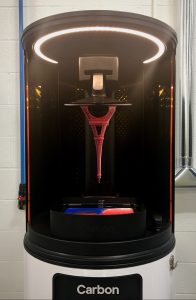As an engineer, you’re always looking for new and better solutions for your design projects. You’ve likely experimented with traditional additive or 3D printing to produce models and prototypes. Besides being slow, the surface finish and mechanical properties are often suspect. But have you tried the newest innovation in 3D printing? Digital Light Synthesis (DLS)!

Enabled by Carbon’s proprietary CLIP Technology, Digital Light Synthesis uses digital light projection, oxygen permeable optics and programmable liquid resins to produce products with much improved durability, resolution and surface finish.
Here’s how it works:
If you’re not familiar with digital light synthesis, here are key items you need to know.
Digital Light Synthesis greatly improves upon the surface and mechanical property issues of traditional 3D printed objects. Because this process doesn’t print layers, the surface of the object is much smoother. The higher quality finish combined with the second chemical reaction from the heat of the forced-circulation oven makes for high resolution parts with engineering-grade mechanical properties.
With the Digital Light Synthesis process, you can create prototypes, test them and run your production all in the same process and with the same material. This saves you time and cost while getting your products to your customers faster.
3D printing with the Digital Light Synthesis process is available with the materials below:
adidas is utilizing DLS with Carbon’s CLIP technology to open up new possibilities in shoe design. Carbon developed a revolutionary elastic material for the midsole of adidas’s new product, Futurecraft 4D. Traditional 3D printing was too slow for production, created wasteful part supports and used materials that were brittle.
Carbon’s Digital Light Synthesis sped up the process and removed the need for prototyping. They were able to test performance in the design phase. It also created products with no support material, eliminating waste. With the results of Digital Light Synthesis, adidas will be able to customize its shoes for optimal performance by sport and by customer.
This is a huge step for the additive manufacturing. These improvements for large volume production can be applied across all industries.
Vowin was one of a select few Beta-sites selected for the Carbon M1 Printer in 2015. Currently, TTH is running six Carbon DLS Machines, including the latest M2 model which offers a larger build platform and double the build volume than the M1 model.


